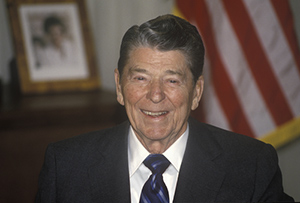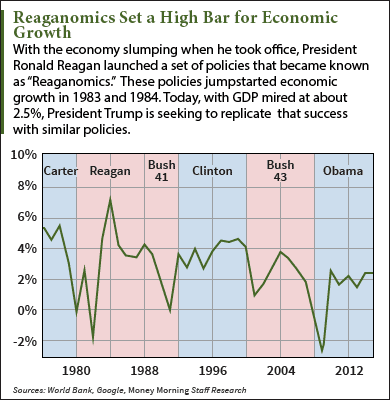While not exactly alike, Trumponomics has enough in common with Reaganomics that pundits are drawing comparisons between the two.
That has raised hopes that Trumponomics -- a shorthand term for Donald Trump's economic proposals - could bring about a 1980s-style boom that would boost the U.S. economy and create jobs.
So let's see if this comparison has any merit.
Putting Reaganomics and Trumponomics Side by Side
 President Ronald Reagan's goal was to restore economic growth in the wake of the stagnant 1970s. Reaganomics was supposed to consist of four pillars:
President Ronald Reagan's goal was to restore economic growth in the wake of the stagnant 1970s. Reaganomics was supposed to consist of four pillars:
- Cutting taxes, both for individuals and businesses
- Reducing government regulation
- Tightening the money supply (higher Federal Reserve interest rates)
- Reducing the growth of government spending
Reagan mostly succeeded in achieving the first three. However, Reagan ran big budget deficits throughout his two terms - more than triple those of his predecessor, Democrat Jimmy Carter. The national debt grew from $997 billion to $2.85 trillion.
Although Reagan did slow spending increases in some areas, others saw significant increases. The one with the biggest impact was defense - the 1987 defense budget was 40% higher than 1980's.
Trending: How to Profit from This 21st Century Arms Race
Now, here's how Trumponomics stacks up. President Trump has proposed:
- Cutting taxes, for individuals but especially for businesses
- Reducing regulations
- Renegotiating America's trade deals
- Investing $550 billion in infrastructure
While some of these proposals would help stimulate the economy, much has changed since Ronald Reagan sat in the White House...
Why Trumponomics Has a Steeper Hill to Climb
Interest rates: When Ronald Reagan took office in January 1981, the effective fed funds rate was an astonishing 19%. Fed Chair Paul Volcker kept rates high through 1981 as part of his battle to defeat inflation - a key goal of Reaganomics.
But those high rates were the main cause of the recession that started in mid-1981 and lasted through 1982. As the Fed cut rates by more than half over the next two years, the lower cost of money provided a massive stimulus. The economy began to grow rapidly, with GDP (gross domestic product) growth peaking at 7.3% in 1984.

Trumponomics will get no such boost.
After nearly eight years of near-zero rates, the Fed only last year began to raise them again. The Federal Open Market Committee (FOMC) is expected to raise the current rate of 0.5% to 0.75% at its December meeting. And going by the Fed dot plot, the central bank intends to keep tightening over the next couple of years.
And ironically, any economic boost Trumponomics provides will push the Fed to speed up its rate hike timetable.
Higher interest rates will slow the U.S. economy, working against other Trumponomics measures aimed at stimulating growth.
Higher spending: Democrats often push for more government spending to stimulate the economy. Despite a goal of reducing government spending, Reagan increased it dramatically.
Most of the increase went to defense, although other departments also saw their budgets rise significantly. No doubt, that rise in spending played a role in the 1980s economic boom.
Donald Trump has also proposed major spending increases. Some of that will go to defense, as happened under Reagan. But Trump also wants to spend about $550 billion on infrastructure.
This will have a stimulative effect on the economy, but Trump has a problem Reagan did not have - the $19.9 trillion national debt. He needs to weigh the risk of adding more debt with the benefits of spending.
Politically, Trump will face opposition from deficit hawks within his own party if his spending gets too ambitious.
Don't Miss: Five Things Donald Trump Has Said About Social Security
Trade deals: Reagan raised some trade barriers, but it wasn't a major piece of Reaganomics. Trump needs to be careful here.
Killing or renegotiating trade deals sounds good, but many of these agreements have been good for the U.S. economy overall even as they cost some jobs.
And raising tariffs carries even more risks, including violating World Trade Organization rules. If Trump follows through on his campaign rhetoric, he risks sparking a trade war that would damage the U.S. economy more than the bad trade deals he likes to denounce.
All that said, these parts of Trumponomics have a real chance to make a difference...
Where Trumponomics Can Succeed
[mmpazkzone name="in-story" network="9794" site="307044" id="137008" type="4"]
Tax cuts: In theory, tax cuts give individuals and businesses more money to spend, thus stimulating the economy. Under Reaganomics, individual tax rates were cut 23% across the board, while the top tax rate fell from 70% to 28%. Reagan also adjusted depreciation rules for businesses to reduce their taxes.
Trump's tax cuts would be nearly as generous to individuals. Corporations, meanwhile, would get a big reduction from 35% to 15%, although Trump has said he'd eliminate a lot of current loopholes and deductions.
These tax cuts, particularly the big reduction in the corporate tax rate, are the part of Trumponomics with the greatest chance for success. But individual rates aren't as much in need of reform, so Trump's cuts here will have less of an impact than Reagan's.
Fewer regulations: President Reagan believed excessive regulations were strangling American businesses. He had some successes. He removed what was left of President Richard Nixon's price controls and reduced bank regulations, which helped the economy.
The number of "final rules" published in the Federal Register declined from 7,745 in 1980 to the 4,500 to 4,700 range in the latter Reagan years.
Trump has also vowed to cut regulations. He wants a rule that would require agencies to eliminate two existing regulations for every new one they wish to implement. Likely targets include sectors like energy, healthcare, and finance.
Because most regulations fall under the executive branch, Trump can make real progress here. A 2013 study by economists John W. Dawson and John J. Seater estimated that GDP would be $38.8 trillion higher had regulations remained at 1949 levels.
Trumponomics is unlikely to produce the kind of GDP growth Reaganomics delivered. But a plan focused on corporate tax reform, targeted spending increases on infrastructure, and fewer regulations has a credible chance of improving on the current Bloomberg consensus GDP forecasts of 2.1% for 2017 and 2.2% for 2018.
Next Up: How to Play Healthcare Stocks in the Donald Trump Era
Follow me on Twitter @DavidGZeiler or like Money Morning on Facebook.
About the Author
David Zeiler, Associate Editor for Money Morning at Money Map Press, has been a journalist for more than 35 years, including 18 spent at The Baltimore Sun. He has worked as a writer, editor, and page designer at different times in his career. He's interviewed a number of well-known personalities - ranging from punk rock icon Joey Ramone to Apple Inc. co-founder Steve Wozniak.
Over the course of his journalistic career, Dave has covered many diverse subjects. Since arriving at Money Morning in 2011, he has focused primarily on technology. He's an expert on both Apple and cryptocurrencies. He started writing about Apple for The Sun in the mid-1990s, and had an Apple blog on The Sun's web site from 2007-2009. Dave's been writing about Bitcoin since 2011 - long before most people had even heard of it. He even mined it for a short time.
Dave has a BA in English and Mass Communications from Loyola University Maryland.



